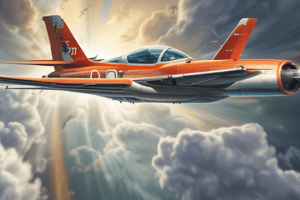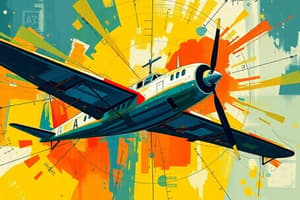Podcast
Questions and Answers
What is the primary purpose of the force of thrust in an airplane?
What is the primary purpose of the force of thrust in an airplane?
- To increase the force of lift
- To reduce the force of parasite drag
- To counteract the force of weight
- To overcome the force of drag (correct)
What is the result of an increase in air speed in an airplane?
What is the result of an increase in air speed in an airplane?
- Thrust and drag become unequal
- Weight becomes greater than lift
- Induced drag decreases exponentially
- Lift becomes greater than weight, and the aircraft climbs (correct)
What is parasite drag caused by?
What is parasite drag caused by?
- The direction of relative wind
- The weight of the aircraft
- The speed of the propeller
- The shape of the aircraft and its components (correct)
What is the term for the air speed range where the least amount of drag is achieved?
What is the term for the air speed range where the least amount of drag is achieved?
What is the result of increasing lift in an airplane?
What is the result of increasing lift in an airplane?
In steady, unaccelerated flight, what is the relationship between lift and weight?
In steady, unaccelerated flight, what is the relationship between lift and weight?
Flashcards are hidden until you start studying
Study Notes
- The video is a part of a free Private Pilot ground course, covering the four forces that act on an airplane in flight: lift, weight, thrust, and drag.
- Lift is the upward force that opposes weight, caused by relative wind and wing design (airfoil).
- Weight is the combined load of the aircraft, people, fuel, baggage, and cargo, and it acts downward through the center of gravity.
- In steady, unaccelerated flight, lift and weight are equal.
- Thrust is the force that propels the aircraft forward, created by an engine and propeller or rotor, and it must overcome drag.
- Drag is the rearward force that opposes forward movement, and it has two types: parasite drag and induced drag.
- Parasite drag increases exponentially with air speed, and it has three types: form drag, interference drag, and skin friction drag.
- Induced drag is created by the wing's direction of relative wind, resulting in lift, but it decreases exponentially with air speed.
- The magical air speed range where the least amount of drag is achieved is referred to as the lift to drag ratio (LD Max).
- In steady, unaccelerated flight, thrust and drag are equal.
- Understanding the relationship between these four forces is crucial for controlling an airplane.
- When air speed increases through thrust, lift becomes greater than weight, and the aircraft climbs.
- When lift is increased, induced drag increases, causing air speed to decrease.
Studying That Suits You
Use AI to generate personalized quizzes and flashcards to suit your learning preferences.




